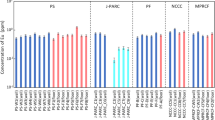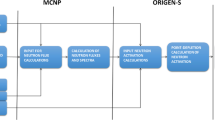Abstract
The dissolution of the Soviet Union coupled with the growing sophistication of international terror organizations has brought about a desire to ensure that a sound infrastructure exists to interdict smuggled nuclear material prior to leaving its country of origin. To combat the threat of nuclear trafficking, radiation portal monitors (RPMs) are deployed around the world to intercept illicit material while in transit by passively detecting gamma and neutron radiation. Portal monitors in some locations have reported abnormally high background counts. The higher background data has been attributed, in part, to the naturally occurring radioactive materials (NORM) in the concrete surrounding the portal monitors. Higher background increases the minimum detectable activity (MDA) and can ultimately lead to more material passing through the RPMs undetected. This work employed two different neutron activation analysis (NAA) methods for the purpose of developing a process to characterize the concrete surrounding the RPMs. Thermal neutron instrumental NAA (INAA) and fast NAA (FNAA) were conducted on six samples from three different composition concrete slabs. Comparator standards and quality control materials were used to help ensure that the methods were both precise and accurate. The combination of INAA and FNAA accounted for 84–100% of the total elemental composition of the samples. Knowing the composition of the concrete will allow RPM customers to choose suitable materials prior to installation, thereby increasing the ability of the monitors to detect radiological and nuclear materials.

Similar content being viewed by others
References
Hevesy G, Levi H (1935) Nature 136:103
Filby RH (1995) Pure Appl Chem 67:1929–1941
Baum EM, Knox HD, Miller TR (2002) Nuclides and isotopes: chart of the nuclides, 16th edn. Knolls Atomic Power Laboratory, Schenectady
Ehmann WD, Ni BF (1992) J Radioanal Nucl Chem 160:169–179
James WD (1997) J Radioanal Nucl Chem 219:187–190
Bereznai T (1980) Fresenius Z Anal Chem 302:353–363
Glascock MD (1991) Tables for neutron activation analysis. University of Missouri Research Reactor Facility, Columbia
Lindstrom RM, Paul RL, Vincent DH, Greenburg RR (1994) J Radioanal Nucl Chem 180:271–275
Dorsey DJ, Hebner R, Charlton WS (2004) J Compos Mater 38:1505–1519
Ryan CM, Marianno CM, Charlton WS, Solodov AA, Livesay RJ (2010) In: Proceedings of 51st annual meeting of the institute of nuclear materials management conference, Baltimore, MD
Acknowledgment
The authors wish to acknowledge Michael Raulerson of the CCCA who performed the INAA and FNAA work described in this paper.
Author information
Authors and Affiliations
Corresponding author
Rights and permissions
About this article
Cite this article
Ryan, C.M., Marianno, C.M., Charlton, W.S. et al. Neutron activation analysis of concrete for cross-border nuclear security. J Radioanal Nucl Chem 291, 267–272 (2012). https://doi.org/10.1007/s10967-011-1272-y
Received:
Published:
Issue Date:
DOI: https://doi.org/10.1007/s10967-011-1272-y




